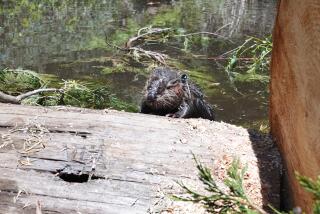Wyoming’s endangered ferrets bouncing back
Black-footed ferrets, one of the most endangered mammals in North America, are staging a rapid comeback in the Shirley Basin of Wyoming, scientists said Thursday.
A decade after they were given up for goners, the ferret population in the area has grown from five to an estimated 220 -- a figure based on surveying 14% of the area’s available habitat, according to a report in the journal Science.
“We hear so much about how the Endangered Species Act is broken and animals go extinct. But when given a chance and when people work together, endangered species can recover,” said Jonathan Proctor of Defenders of Wildlife, who was not connected with the study.
Lead author Martin Grenier of Wyoming Game and Fish and the University of Wyoming said it was still unclear why the ferret had made such a comeback.
“We need to look back within ourselves and say, OK, what piece of the puzzle are we missing?” he said. “Why are we not seeing this kind of pattern at all our sites?”
Black-footed ferrets, the only species of ferret native to North America, have been listed as endangered since the original version of the act in 1967.
The ferret is nocturnal and secretive, and preys almost exclusively on prairie dogs. Both animals once lived throughout much of central North America, but habitat destruction and prairie dog poisoning, largely to help farmers and ranchers, had drastically reduced their numbers.
From 1974 to 1981, the ferrets were thought to be extinct. A small population was later discovered near Meeteetse, Wyo., and authorities removed the animals to start a captive-breeding program.
The ferrets were reintroduced to the Shirley Basin in 1991 and later to about a dozen other sites. No ferrets were transplanted to the Shirley Basin after 1994.
Only one location -- the Conata Basin in South Dakota -- initially proved to be successful. Meanwhile, sylvatic plague took a toll in the Shirley Basin. After Wyoming Game and Fish workers found only five ferrets in 1997, monitoring became sporadic.
But in 2003, 52 animals were found, and the numbers have since gone up exponentially.
“We shouldn’t be giving up on things too early,” said Mike Lockhart, the U.S. Fish and Wildlife Service’s black-footed ferret recovery coordinator.
“Shirley Basin gives us hope -- we really believe we can recover black-footed ferrets biologically,” said Travis Livieri, who runs the nonprofit group Prairie Wildlife Research.
Although the ferrets in the Shirley Basin are doing well, their kin in the Conata Basin may again be at risk.
The Forest Service released a draft environmental impact statement in May for prairie dog management in an area that includes the Conata Basin. Most of the proposals allow more poisoning of prairie dogs on public land.
Proctor said killing the prairie dogs would undo the years of work and millions of dollars spent to bring back the ferret.
--
More to Read
Sign up for Essential California
The most important California stories and recommendations in your inbox every morning.
You may occasionally receive promotional content from the Los Angeles Times.










